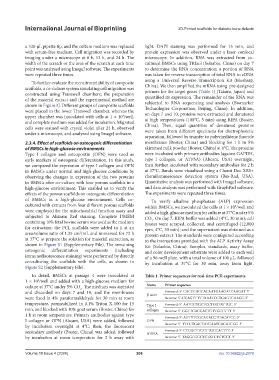Page 216 - IJB-10-4
P. 216
International Journal of Bioprinting 3D-Printed scaffolds for diabetic bone defects
a 100-μL pipette tip, and the culture medium was replaced light. DAPI staining was performed for 15 min, and
with serum-free medium. Cell migration was recorded by protein expression was observed under a laser confocal
imaging under a microscope at 0 h, 12 h, and 24 h. The microscope. In addition, RNA was extracted from co-
width of the scratch or the area of the scratch at each time cultured BMSCs using TRIzol (Solarbio, China) on day 7
point was analyzed using ImageJ software. The experiments to determine the RNA concentration; a portion of RNA
were repeated three times. was taken for reverse transcription of total RNA to cDNA
To further evaluate the recruitment ability of composite using a Universal Reverse Transcription Kit (Biosharp,
scaffolds, a co-culture system simulating cell migration was China). We then amplified the mRNA using pre-designed
constructed using Transwell chambers; the preparation primers for the target genes (Table 1) (Takara, Japan) and
of the material extract and the experimental method are quantified its expression. The remainder of the RNA was
shown in Figure 3J. Different groups of composite scaffolds subjected to RNA sequencing and analysis (Biomarker
were placed in the lower Transwell chamber, whereas the Technologies Corporation, Beijing, China). In addition,
upper chamber was inoculated with cells at 1 × 10 /well, on days 7 and 10, proteins were extracted and denatured
4
and complete medium was added for incubation. Migrated at high temperatures (100°C, 5 min) using RIPA (Boster,
cells were stained with crystal violet after 24 h, observed China). Then, equal quantities of denatured proteins
under a microscope, and analyzed using ImageJ software. were taken from different specimens for electrophoretic
separation, followed by transfer to polyvinylidene fluoride
2.3.4. Effect of scaffolds on osteogenic differentiation membranes (Boster, China) and blocking for 1 h in 5%
of BMSCs in high-glucose environments skimmed milk powder (Boster, China) at 4°C. The proteins
Type I collagen and osteopontin (OPN) were used as were incubated with primary antibodies (against GAPDH,
early markers of osteogenic differentiation. In this study, type I collagen, or ATP5A) (Abcam, USA) overnight,
we compared the expression of type I collagen and OPN then further incubated with secondary antibodies for 2 h
in BMSCs under normal and high-glucose conditions by at 37°C. Bands were visualized using a Chemi Doc XRS+
observing the changes in expression of the two proteins chemiluminescence detection system (Bio-Rad, USA).
in BMSCs after co-culture with four porous scaffolds in a Quantitative analysis was performed with ImageJ software,
high-glucose environment. This enabled us to verify the and data analysis was performed with GraphPad software.
effects of the porous scaffolds on osteogenic differentiation The experiments were repeated three times.
of BMSCs in a high-glucose environment. Cells co- To verify alkaline phosphatase (ALP) expression
cultured with extracts from four different porous scaffolds within BMSCs, we inoculated the cells at 1 × 10 /well and
5
were employed for the mitochondrial function assay and added a high-glucose medium for culture at 37°C under 5%
subjected to Alizarin Red staining. Complete DMEM CO . On day 7, RIPA buffer was added (4°C, 30 min); cell
containing 10% fetal bovine serum was used as the medium lysates were scraped, collected, and centrifuged (12,000
2
for extraction; the PCL scaffolds were added to it at an rpm, 4°C, 30 min); and the supernatant was obtained as a
area:volume ratio of 1.25 cm /mL and immersed for 72 h protein extract. The standards were configured according
2
at 37°C to prepare the solution for material extraction, as to the instructions provided with the ALP Activity Assay
shown in Figure S1 (Supplementary File). The remaining Kit (Solarbio, China). Samples, standards, assay buffer,
osteogenic differentiation experiments (including and color development substrate were added to each well
immunofluorescence staining) were performed by directly of a 96-well plate, with a total volume of 100 μL, followed
co-culturing the scaffolds with the cells, as shown in by incubation at 37°C for 30 min, away from light.
Figure S2 (Supplementary File).
In detail, BMSCs at passage 4 were inoculated at Table 1. Primer sequences for real-time PCR experiments
1 × 10 /well and added with a high-glucose medium for
5
culture at 37°C under 5% CO . The medium was aspirated Name Primer sequence
2
and discarded on days 7 and 10, and the membranes β-actin Forward: 5’-CACCCAGCACAATGAAGATCAAGAT-3’
were fixed in 4% paraformaldehyde for 30 min at room Reverse: 5’-CCAGTTTTTAAATCCTGAGTCAAGC-3’
temperature, permeabilized in 0.1% Triton X-100 for 15 Type I Forward: 5’-AATGGTGCTCCTGGTATTGC-3’
min, and blocked with 10% goat serum (Boster, China) for collagen Reverse: 5’-GGTTCACCACTGTTGCCTTT-3’
1 h at room temperature. Primary antibodies against type Forward: 5’-AGTTTCGCAGACCTGACATCC-3’
I collagen or OPN (Abcam, USA) were added, followed OPN
by incubation overnight at 4°C; then, the fluorescent Reverse: 5’-TTCCTGACTATCAATCACATCGG-3’
secondary antibody (Boster, China) was added, followed ATP5A Forward: 5’-CTCGCTTCGTTGCCACTTC-3’
by incubation at room temperature for 2 h away with Reverse: 5’-TAGGCGGCTCTATCTCTCGT-3’
Volume 10 Issue 4 (2024) 208 doi: 10.36922/ijb.2379

